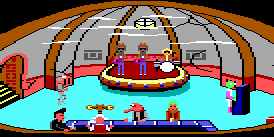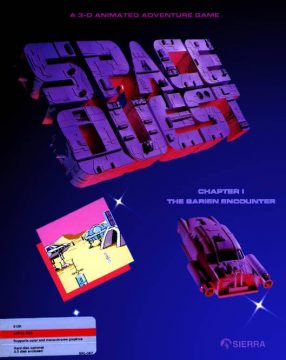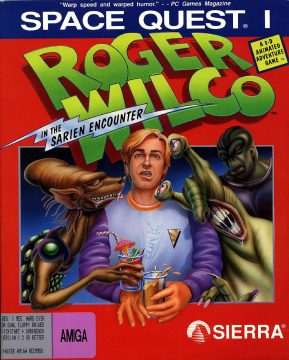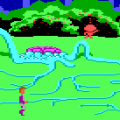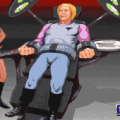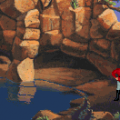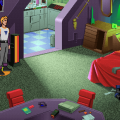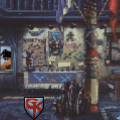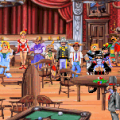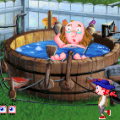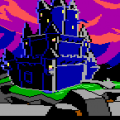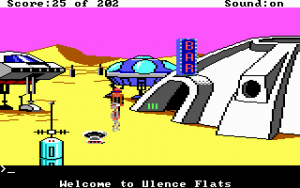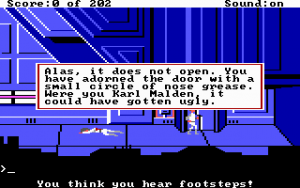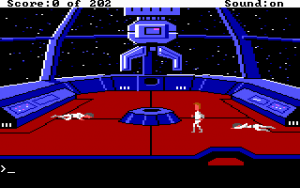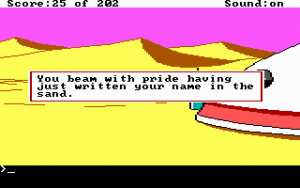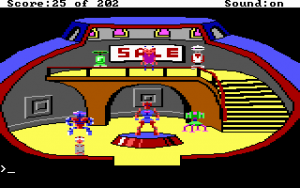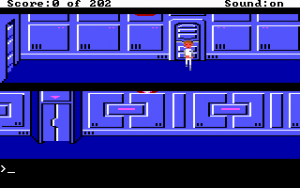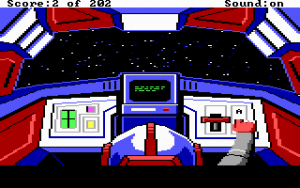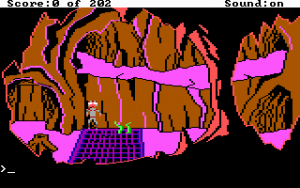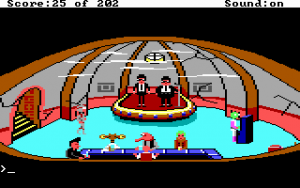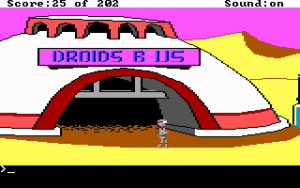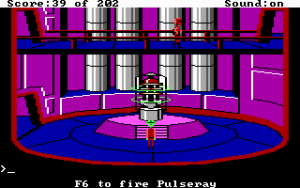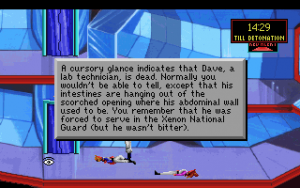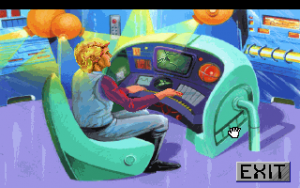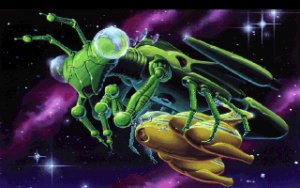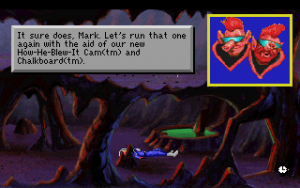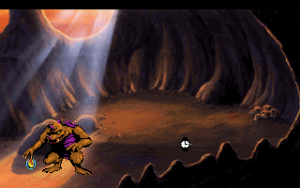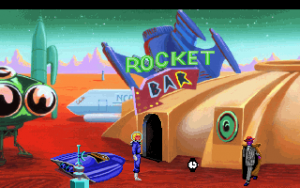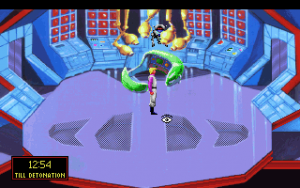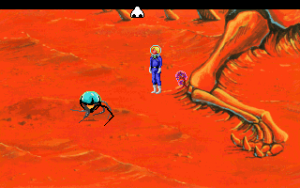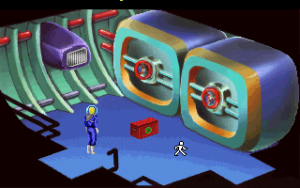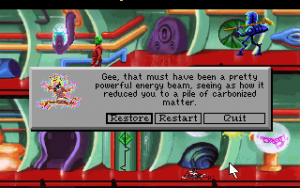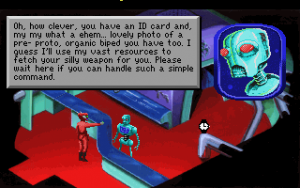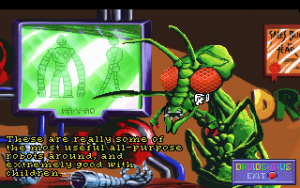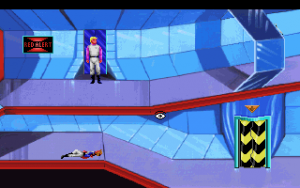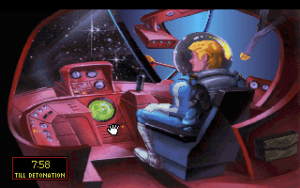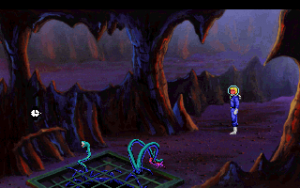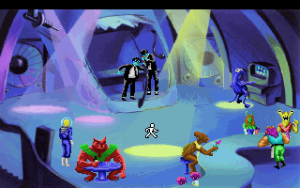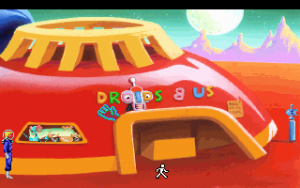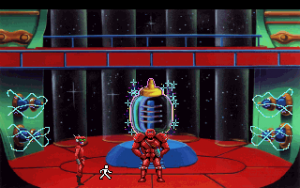When Sierra released King’s Quest in 1984, it took the computer gaming world by storm. Sierra then branched out by developing adventure games with other themes, including Police Quest, Leisure Suit Larry, and Space Quest.
Space Quest is more than just King’s Quest with a sci-fi theme. Helmed by two Sierra employees who called themselves The Two Guys from Andromeda – Scott Murphy, the programmer, and Mark Crowe, the artist – Space Quest featured a slightly more off-kilter sense of humor. Instead of a great king-to-be, the hero (whom the player can name in the first game, although he was officially named Roger Wilco in later installments) is little more than a mere janitor, and a fairly incompetent one at that. (This premise may have been borrowed from Infocom’s Planetfall.) At the beginning of the first game, he survives an attack on his ship only because he decided to take a nap in the closet when he should’ve been on duty. Most of the games involve poor Roger simply stumbling from incredulous situation to incredulous situation, somehow saving the day in spite of his general ineptitude.
Or… not. Sierra games are known to be particularly punishing to the player, especially when it comes to death scenes. Space Quest takes this and runs with it, with a number of amusingly sardonic ways for Roger to die. At least if you do something wrong, it tends to garner a chuckle. The narrator is often the most amusing “character”, offering sarcastic commentary on Roger’s every action.
Space Quest is also full of references to and parodies of various works of science fiction. Part of the fun is trying to pick out the most witty ones, because there are some pretty obscure entries throughout the series. Starting around Space Quest III, the series also became amusingly self-referential, featuring the real-life creators of the series as captives to be rescued, and goes even further with Space Quest IV, with Roger time traveling through his own (non-existent, sadly) sequels. It’s prototypical of the style of humor found in Futurama.
Like most adventure games and works of science fiction, Space Quest also excels by creating an entertaining universe filled with unique characters and locations, some of which recur throughout the series. Some of these include Monolith Burger, the interstellar version of McDonalds; Astro Chicken, a series of playable arcade games made by evil software development house ScumSoft, Inc; the mega villain Sludge Vohaul, Roger’s accidental arch-nemesis; and the Gippazoid novelty company, who refuse to forgive Roger for a minor incident committed in Space Quest II.
There are six games in the Space Quest series, as well as a VGA remake of the first game, which was typical treatment for many of the more popular Sierra franchises. Other than Mark Crowe and Scott Murphy, one of the key members included Josh Mandel, who contributed some writing and developed much of Space Quest VI.
The first Space Quest episode begins with our hero, Roger Wilco, taking a nap on the closet. This act of severe laziness ends up saving his hide, as the rest of the entire active crew of his spaceship, the Arcada, has been killed by the Sariens, who have invaded the ship and stolen the powerful Star Generator. After sneaking out and hijacking an escape pod, Roger ends up on the desert planet Kerona, where he must evade numerous dangerous creatures, including a spider-like robot sent by the Sariens. Upon discovering a Wizard of Oz-like scientist who lives under the surface, Roger takes his speeder to Ulence Flats (reverse those two words for an almost-clever gag), one of the only establishments on the planet. After winning it big at the Slots of Death (getting triple skulls results in being vaporized) and overhearing the location of the Sariens, Roger affords himself the luxury of a navigational robot and spaceship, and heads off to disable the Star Generator himself.
Space Quest I comes in two flavors: The original EGA version, released in 1986, and the updated VGA version, released in 1991. The EGA version uses the AGI engine found in all of Sierra’s early graphic adventures, which means low res 160×200, blocky, 16 color graphics, keyboard/joystick movement, full text input, and in the DOS version, PC speaker sound. The VGA version uses the SCI1 interpreter, which means 256 color graphics with painted backgrounds, a fully icon-based interface with mouse control, and support for sound cards.
The plot remains unchanged in the remake, and only a few of the puzzles have been slightly altered due to the new interface. In some ways, though, more could’ve been done to fix it up for the re-release. Compared to the free roaming worlds of King’s Quest and Leisure Suit Larry, Space Quest is awfully short and linear. This is actually a blessing in disguise, since there are quite a few instances where you can miss a vital item and find yourself in an unwinnable situation. Before you escape from the Arcada, you’d better make sure to grab the gadget by the spacesuit, which will translate the gibberish spoken by the hologram you find underground in Kerona. And whatever you do, don’t accept the first offer from the spaceship salesman in Ulence Flats. You’re supposed to reject the first offer, so that way he throws in a jetpack as a free bonus when he tries a second time. You obviously need this jetpack for the final sequence – it’s a right old bit of Sierra-style trickery.
The graphics in the remake have the feel of a cheesy sci-fi B-movie, which suits the game perfectly. The VGA version features the usual “Walk”, “Use” and “Talk” icons, but introduces the “Smell” and “Taste” icons. These don’t have any real use other than provoking a few humorous responses, although they’re (slightly) better utilized in Space Quest IV. The VGA remake includes a magnet item which helps you rig a slot machine at the bar. In the original EGA game, you needed to play your luck – a bit tough, considering that you’re killed if you happen to get three skull and crossbones. The VGA version also lets you skip the arcade sequence, where you pilot a skimmer across a desert, although it chastises you for doing so.
One of the jokes has also been changed. In the EGA version, if you pushed the “Do Not Press” button in the escape pod, you end up transporting to Daventry Castle in the first King’s Quest. In the VGA version, you end up outside of Nottingham Castle from Conquests of the Longbow, which was a more contemporary game at the time the remake was released.
Given that it’s the first game in the series, Space Quest hadn’t exactly found its voice yet. It’s certainly funny, but other than a slightly sarcastic narrator and some mildly amusing death scenes (including one in the VGA version where the Two Guys pop up and announce an instant replay of one of Roger’s particularly stupid moments), it’s not really as hilarious as its sequels. The VGA version adds a lot more location and event descriptions, at least.
Most of the humor comes from references to pop culture and other sci-fi series. The bar in Ulence Flats features alien versions of the Blues Brothers and ZZ Top, although the latter was changed in the VGA version due to a complaint from the musicians themselves. The EGA version features PC speaker renditions of the Blues Brother’s theme and ZZ Top’s “Sharp Dressed Man”, while the VGA version features different but similarly styled pieces of music. When shopping for robots in the VGA version, you’ll find a number of classics, including the Robot from Lost in Space, Robby the Robot from The Forbidden Planet, and a creature that looked like it stepped out of Laputa: Castle in the Sky called Hay-A-O, a reference to the film’s director, Hayao Miyazaki. The arms dealer on the Sarien ship also sounds suspiciously like Marvin the Paranoid Android from Douglas Adam’s The Hitchhiker’s Guide to the Galaxy series. The robot shop itself was named Droids R Us in the EGA version, but changed to Droids B Us in both future revisions and the VGA version due to a lawsuit from the toy retailer. Strangely, the VGA version goes one step further and features a green giraffe that looks suspiciously like Jeffrey, the Toys “R” Us mascot.
Screenshot Comparisons
